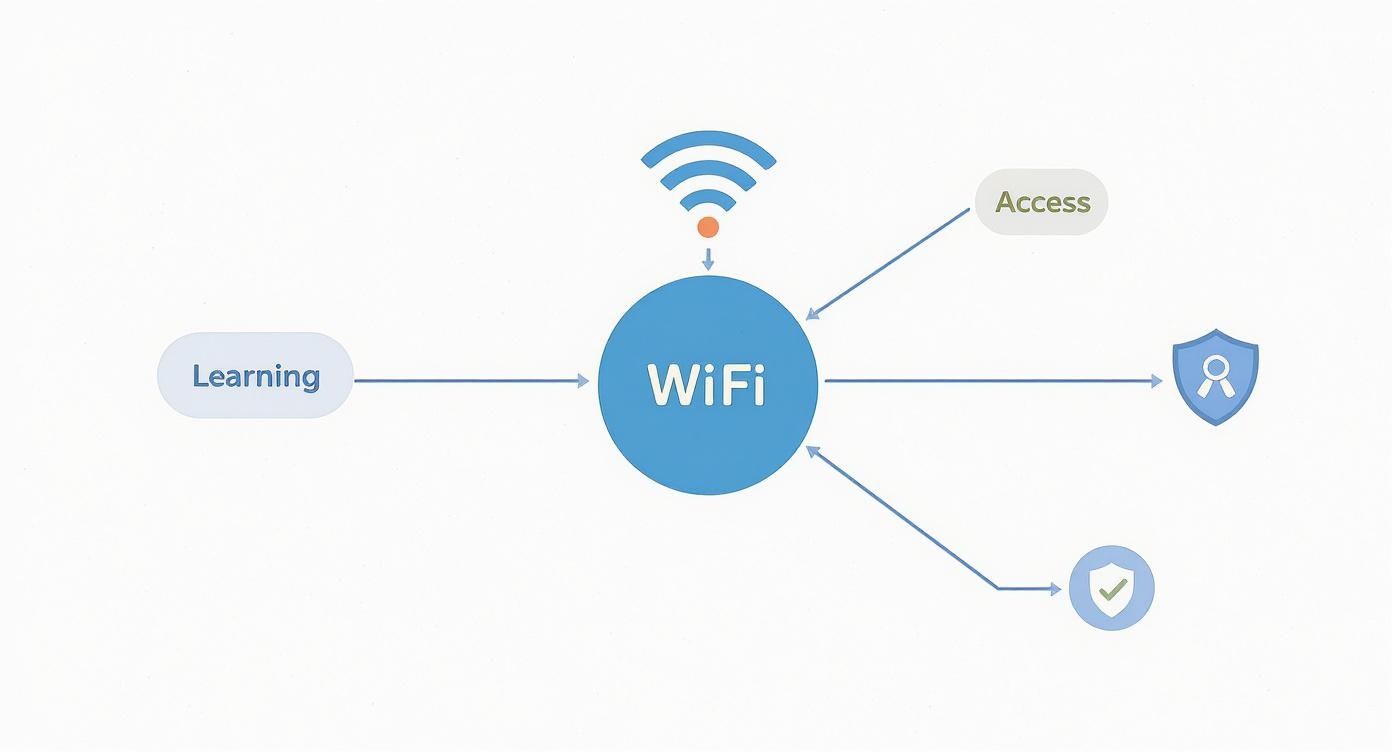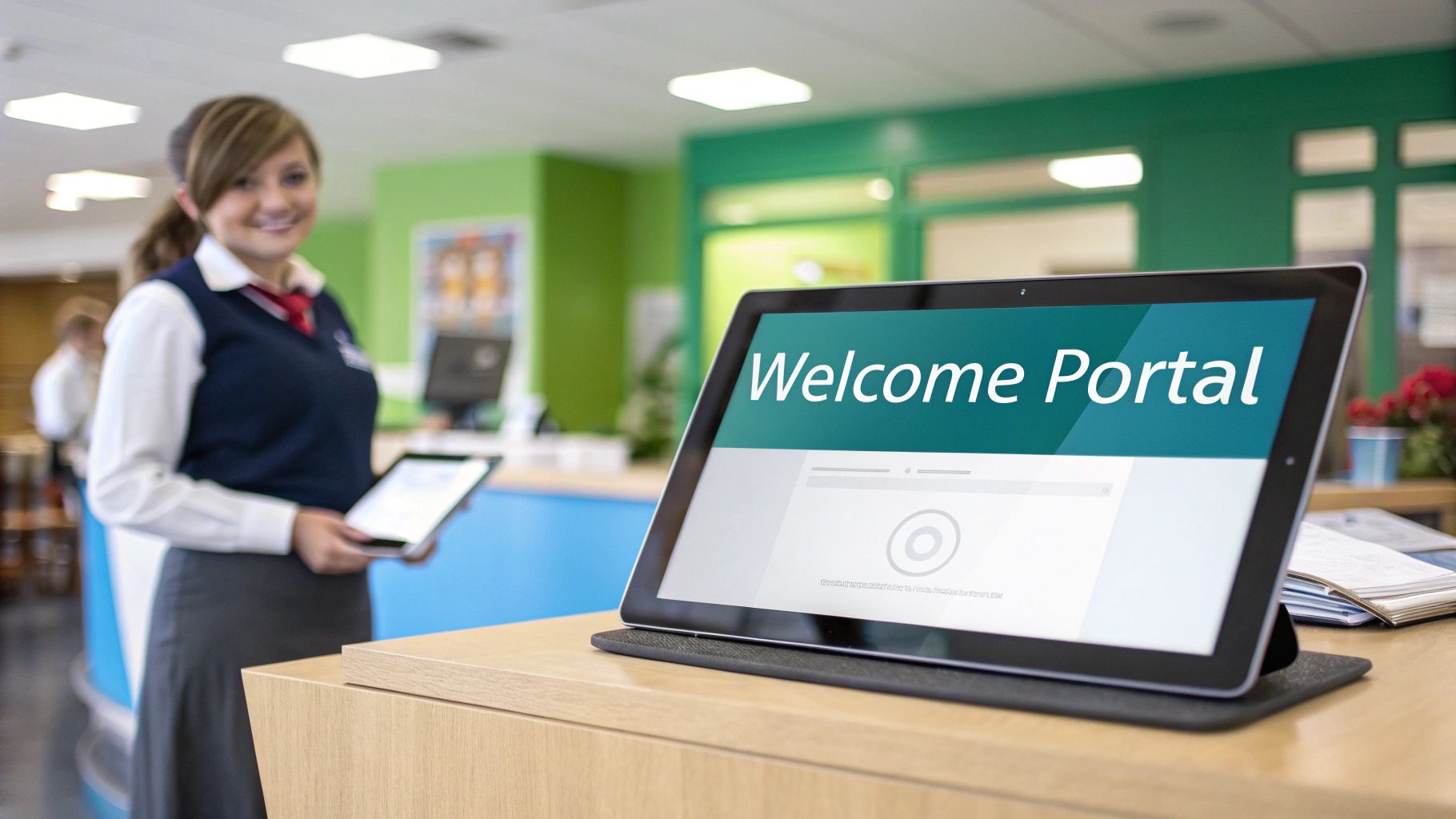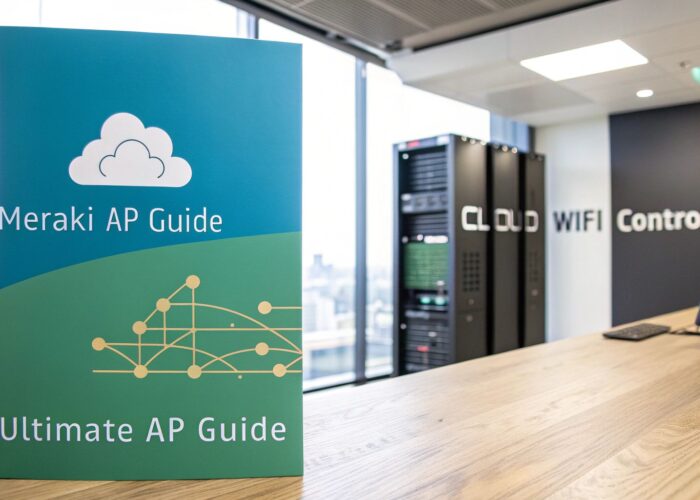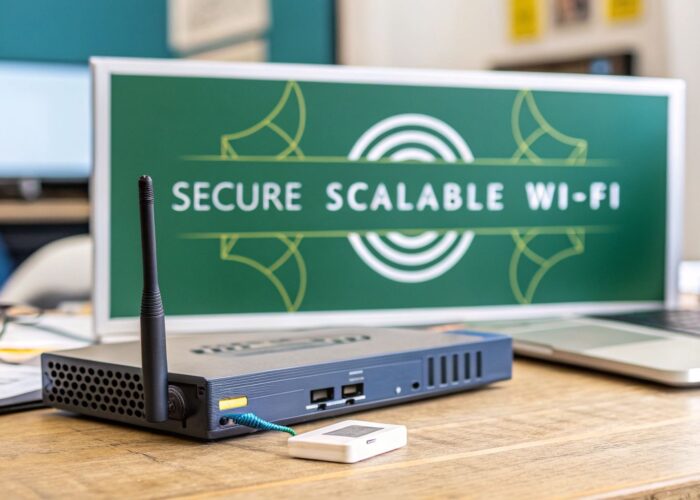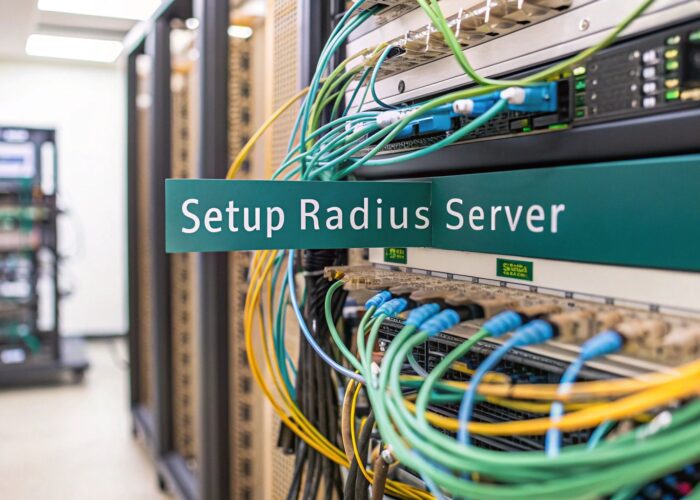Let's talk about wifi for schools. It's officially moved from a "nice-to-have" to a core utility. Just like electricity and running water, reliable wireless connectivity is now a fundamental requirement for any modern learning environment. Without it, the lights of modern education simply don't turn on.
The New Backbone of Modern Education
Picture a typical day on campus. Students are digging into digital textbooks on their tablets, teachers are running interactive lessons on smartboards, and everyone is collaborating on projects saved to the cloud. None of that happens without a strong, stable Wi-Fi network humming in the background. It has become the invisible, yet absolutely essential, backbone of day-to-day learning.
This creates a real challenge for IT administrators, doesn't it? How do you deliver the open, seamless access that students and teachers need, while also locking down sensitive data and protecting the network itself? It’s not just about getting devices online; it’s about creating a safe and effective digital learning space.
Why School WiFi Is More Than Just Internet Access
Let's be clear: a top-tier school Wi-Fi network is about much more than just providing a signal. It's about building a complete digital ecosystem that can handle everything a modern school throws at it. Here are the core pillars that make it all work.
| Core Pillar | Why It Matters for Education |
|---|---|
| Accessibility | Ensures every student and teacher can connect easily from anywhere on campus, eliminating digital barriers to learning. |
| Security | Protects student data, prevents unauthorized access, and keeps the network safe from threats. |
| Scalability | Accommodates a growing number of devices—from school-issued laptops to personal phones—without slowing down. |
| Management | Gives IT teams the tools to easily monitor the network, control access, and troubleshoot issues quickly. |
Ultimately, a well-designed network has to be flexible enough to support a one-to-one device program and a Bring-Your-Own-Device (BYOD) policy at the same time. This is where platforms from partners like Cisco Meraki really shine, offering the tools to manage these complex scenarios—a challenge familiar to anyone managing Wi-Fi in busy corporate or retail settings.
Today's school network needs to be as dynamic as the learning it supports. It must intelligently manage different user groups—students, faculty, and guests—each with unique access needs and security profiles.
This isn't a niche concern; it's a major focus for investment. The global Wi-Fi in Education market has already hit USD 7.1 billion and is expected to climb even higher, which tells you just how critical this infrastructure has become.
Securing Every Connection
A huge piece of the puzzle is figuring out who is connecting to your network and what they should be allowed to do. This is where modern authentication solutions come in.
The old method of sharing a single password with everyone is a security nightmare. Today’s networks are much smarter, using tools like:
- Captive Portals: These are the welcome pages that greet users, often requiring them to accept an acceptable use policy before getting online.
- IPSK (Identity Pre-Shared Key): Also known as EasyPSK, this approach gives every user or device its own unique "digital key" to the network.
Think of IPSK like a personal keycard instead of a master key. If a student loses their tablet or their credentials are compromised, the IT team can instantly revoke access for that one device without disrupting anyone else. This kind of granular control is a game-changer for maintaining a secure and orderly network in any Education environment.
Of course, a powerful network is only one part of the equation. You also need the devices that connect to it. Finding funding for student laptops and tablets is a critical step, and there are many sources of grant money for computers in education available to help schools build out their digital campuses.
Building Your Network Foundation with Cisco Meraki
Think of your school's Wi-Fi network like the very foundation of a new building. The access points are the doors, letting students and staff connect. The network switches are the hallways, directing all that digital traffic so no one gets stuck in a bottleneck. And the Cisco Meraki dashboard? That’s your central command center, giving you a bird's-eye view and complete control over the entire campus.
Getting this foundation right from the start is absolutely crucial. If the core is weak, any fancy features you layer on top are bound to crumble. This is where a cloud-managed network really shines, especially for school IT teams that are perpetually short on time and staff.
The biggest win is simplicity right out of the box. Instead of spending days or weeks on-site tinkering with individual devices, Meraki access points can be up and running in minutes. Just plug them in, and they automatically find the cloud, pull down their configurations, and get to work. This "zero-touch provisioning" is a lifesaver for IT staff.
This infographic paints a great picture of how Wi-Fi is the thread connecting learning, security, and access across a modern school.
As you can see, these three pillars are completely intertwined. A solid network is what makes it all possible.
Centralized Command for Every Campus
One of the biggest headaches for any school district's IT department is juggling networks across multiple sites. Nobody wants to drive across town from the elementary school to the high school just to troubleshoot a single misbehaving access point. The Meraki dashboard completely eliminates this problem by pulling your entire network—no matter how spread out—into a single pane of glass on the web.
From this one dashboard, you can do it all:
- See network health at a glance: Get a real-time look at every connected device, watch traffic patterns, and spot potential problems before they disrupt a class.
- Troubleshoot from anywhere: Run diagnostics, reboot an AP in a specific classroom, or tweak bandwidth rules from your office—or even your couch.
- Scale up with ease: Adding a new building or even an entirely new school to the network is as simple as plugging in the new gear and claiming it in your dashboard.
This kind of control changes everything. It means a small IT team can confidently manage a large, complex network, letting them focus on supporting education instead of constantly putting out fires. Of course, even with great tools, a solid network starts with smart planning and a professional Wi-Fi design that accounts for the unique layout and needs of your school.
Integrated Security from the Ground Up
A powerful network has to be a secure one, period. Meraki hardware isn't just about connectivity; it comes with essential security features baked right in, giving you a strong first line of defense. This includes a built-in firewall and, crucially, automatic security updates that protect you from the latest threats without your team having to lift a finger.
A cloud-managed network isn't just about convenience; it's about building a resilient, secure, and scalable digital environment that grows with your school's needs.
This built-in security is incredibly valuable anywhere you're managing a ton of personal devices, whether it’s a school with a BYOD program or even a large retail space. The goal is the same: give people easy access but maintain tight control and visibility. When you combine this solid Cisco foundation with smarter authentication solutions like a Captive Portal or IPSK/EasyPSK, you create a network that is both user-friendly and buttoned-up. If you want to dig deeper into the technology, you can learn more about what is Cisco Meraki and see how it works.
Creating a Welcoming and Secure Front Door
Think of your school's Wi-Fi network as the digital version of your campus. Just like the main entrance to your school building, your network needs a proper front door. This is where a captive portal comes in—it’s the friendly and secure reception desk for everyone who wants to connect. It's the very first interaction students, staff, and guests have with your online environment.
A well-designed captive portal, especially when built on a powerful platform like Cisco Meraki, is far more than a simple login screen. It becomes your school's digital welcome mat and a key communication tool. Instead of just a sterile password box, it can be a vibrant space to display important school announcements, share upcoming event schedules, or remind users of the acceptable use policy they need to follow.
This simple step transforms a technical necessity into a genuine opportunity for engagement. It reinforces your school's brand and community spirit from the moment someone connects. You can see the full range of possibilities when you learn more about a powerful wifi captive portal and how it can completely change the user experience.
More Than Just a Login Screen
The real strength of a captive portal is its flexibility. It gives you a structured onboarding process that ensures every single user is properly authenticated and fully aware of the rules. This simple checkpoint is absolutely essential for managing a modern school Wi-Fi network, where countless different devices are trying to connect every day.
For instance, a captive portal allows you to:
- Communicate Clearly: Post welcome messages, broadcast emergency alerts, or provide direct links to important school resources right on the login page.
- Enforce Policies: Require users to click "agree" to your terms of service or acceptable use policy before granting access—a critical step for compliance.
- Segment Users: Automatically direct different groups—like students, faculty, or guests—to specific login methods or network policies tailored for them.
This is a core component of smart authentication solutions. It guarantees that the right people get the right level of access, all while presenting a polished, professional front door to your network.
Authentication for Every Scenario
This need for managed access isn't just an education thing. Think about other busy environments. In a retail shop, a captive portal might display the latest promotions or ask for an email in exchange for free Wi-Fi. In a BYOD corporate setting, it ensures visiting clients agree to the company's network security terms before connecting their personal devices. The principle is the same across the board: create a secure, controlled, and branded entry point.
A captive portal transforms network access from a simple password entry into a strategic tool for security, communication, and brand reinforcement.
For schools, this level of control is non-negotiable for managing the diverse mix of devices on campus. The onboarding process can be customized to handle everything from school-issued Chromebooks to the personal smartphones that students bring from home. Advanced solutions can even integrate with systems like IPSK or EasyPSK, creating a seamless experience where different user groups are authenticated using the most appropriate method for them.
The availability of robust internet in schools has grown by leaps and bounds. Many districts now aim for access at 1 megabit per second per student, a massive jump from just a few years ago. Even so, challenges in equitable access remain, which makes well-managed systems even more crucial for making the most of every bit of bandwidth. By establishing this digital front door, you're building a network that is welcoming, secure, and ready to support the next generation of learning.
Using Smart Keys for Every User and Device
Relying on a single, shared Wi-Fi password for your entire school is a bit like handing out the same master key to every student, teacher, and visitor. Sure, it’s easy at first, but if just one person loses that key or shares it where they shouldn't, your entire digital campus is suddenly wide open. That old approach just doesn't cut it for modern wifi for schools, where security and control are everything.
Thankfully, there's a much smarter way to handle network access. Today's advanced authentication solutions are moving schools away from that vulnerable shared password model. Instead, they’re embracing a system where every single connection is managed and secured individually. It’s a complete shift in how we should think about who gets on our network.
This modern method is built around a concept called Identity Pre-Shared Key, or IPSK. The easiest way to think about it is giving each user, device, or group their own unique, private key to the Wi-Fi.
The Power of Individual Keys with IPSK and EasyPSK
Imagine being able to instantly create and assign a separate Wi-Fi password for every single connection. A student gets one key for their laptop, a teacher gets another for their tablet, and the smartboard in the science lab gets its very own. This is exactly what IPSK—and user-friendly systems built on it like EasyPSK—makes possible.
This level of detailed control is a huge leap forward for any IT administrator, especially in a bustling education environment. Instead of one password to rule them all, you suddenly have hundreds or even thousands of unique keys, each tied to a specific identity.
This granular approach delivers some powerful, immediate benefits:
- Pinpoint Control: If a student’s device is lost, stolen, or acting suspiciously, you can revoke its specific key in seconds without disrupting anyone else on the network.
- Enhanced Security: A compromised key only affects a single user or device, not the entire school. This dramatically contains the potential damage from any security breach.
- Clear Visibility: IT teams can see exactly who and what is connected to the network at all times. This makes it so much easier to track usage and spot unusual activity before it becomes a problem.
By moving beyond a single shared password, you’re building a network foundation that’s far more resilient and manageable. This is an absolutely critical step for any school managing a Bring-Your-Own-Device (BYOD) policy.
Managing Access in a Diverse BYOD Environment
The reality of today’s schools is a wild mix of school-owned equipment and personal devices. Students bring in their smartphones, teachers use their own laptops, and guests need temporary internet access. This is where a system built on IPSK, especially when layered on top of a Cisco Meraki network, truly shines.
You can create different keys for different groups, each with its own set of rules. For example:
- Students: Their keys might grant access only during school hours and automatically filter out certain websites.
- Faculty: Their keys could provide broader access to internal resources, like shared servers and staff printers.
- Guests: You can issue a temporary key through a Captive Portal that offers internet-only access and expires automatically after 24 hours.
- School Devices: IoT devices like security cameras or smart thermostats can have their own permanent keys that lock them into a specific, highly secure part of the network.
This isn't just about security; it's about creating an intelligent, organized network where every connection has a clear purpose and a defined set of permissions.
This same logic works perfectly in other sectors, too. A retail store could issue unique keys for its point-of-sale systems, staff devices, and public guest Wi-Fi, keeping all three completely separate and secure. A BYOD corporate office could use EasyPSK to quickly onboard new employees and contractors, giving them the right level of access without complicated configurations. The principles of secure, identity-based access are universal.
The ability to create, manage, and revoke these keys is a cornerstone of modern network management. For anyone interested in the technical details, learning more about getting a security key for wifi provides a deeper look into how these systems are put into practice. This approach fundamentally changes how administrators secure their networks, making them more agile and far less vulnerable. By giving everyone their own key, you’re not just locking the door—you’re upgrading to a modern, intelligent security system.
Layering Your Digital Campus Security
Protecting a modern school’s network is a lot like securing the physical campus itself. You wouldn't just lock the main gate and call it a day, right? You have locks on individual classrooms, security cameras in the hallways, and strict rules about who can access sensitive areas. Your digital campus deserves that same multi-layered, thoughtful approach.
This is where the real magic happens when you pair the robust, built-in security of a Cisco Meraki network with advanced authentication solutions. Instead of just playing whack-a-mole with threats, you build a network where security is part of its DNA. The goal is to give IT admins the tools to confidently manage their network’s security, not just react to problems after they happen.
Creating Secure Zones with Network Segmentation
One of the most powerful moves in your security playbook is network segmentation. Simply put, it’s the practice of dividing your single Wi-Fi network into multiple, isolated virtual networks. Think of it as creating separate, secure wings in a building for different groups.
With a segmented network, you can guarantee that student traffic never crosses paths with the administrative network holding sensitive financial records or staff information. It’s a fundamental step in walling off your school's most critical data.
This strategy is incredibly effective and used far beyond the education world.
- A retail store can isolate its secure point-of-sale systems from the free guest Wi-Fi it offers shoppers.
- A corporate office with a BYOD (Bring Your Own Device) policy can create a separate network just for employees' personal phones and tablets, keeping them safely away from core company servers.
Tools like IPSK (Identity Pre-Shared Key) or EasyPSK make this incredibly simple to manage. You can assign keys that automatically steer a user or device onto the correct segmented network the moment they connect, with zero extra work for the end-user.
Filtering Content and Ensuring Compliance
Keeping students safe online is non-negotiable. This means having solid content filtering in place to block access to inappropriate or dangerous material. A properly configured Wi-Fi for schools network has to enforce these rules without fail on every single connected device, from school-issued Chromebooks to students' own smartphones.
This isn't just a good idea; it's often the law. Regulations like the Children's Internet Protection Act (CIPA) in the U.S. require schools to use technology that protects minors from harmful online content.
A layered security approach doesn't just block threats; it creates a controlled, safe, and productive digital environment where students can learn and explore without unnecessary risk.
Modern platforms like Cisco Meraki make this easy, offering powerful content filtering tools right in their main dashboard. This lets IT teams apply different filtering policies to different groups—say, a more restrictive policy for elementary school students than for high schoolers—and ensure the school stays compliant. To build a solid foundation, it's always smart to review the core best practices for network security that these technologies are built on.
Using Analytics to Spot and Stop Threats
The final piece of the puzzle is visibility. After all, you can't protect what you can't see. A well-designed school Wi-Fi system provides clear analytics that help IT staff monitor what’s happening on the network and quickly spot unusual behavior. This could be anything from a single device hogging a massive amount of bandwidth to a sudden surge in traffic heading to a suspicious website.
This is where a solution that ties directly into your Meraki network proves its worth. By analyzing traffic patterns and device behavior, you can catch potential security threats as they emerge. For example, if a student’s device suddenly starts acting like it's been infected with malware, the system can flag it. From there, an IT admin can use an IPSK key to instantly quarantine that device, kicking it off the network before it can spread trouble.
This combination of strong authentication via a Captive Portal, precise control with IPSK, and smart analytics creates a unified defense that keeps your digital campus safe from every angle.
Turning Network Data Into Actionable Insights
Your school's Wi-Fi network is far more than just a utility for getting people online. It's actually a goldmine of data that can help you make smarter, more informed decisions about how your campus truly functions day-to-day. By digging into network analytics, you can shift from simply providing a connection to deeply understanding how your digital campus is being used.
This isn't about tracking individuals or playing Big Brother. It’s about making the most of your resources. When you have a platform that works hand-in-glove with your Cisco Meraki network, you get a clear window into critical operational details. This means seeing what kinds of devices are connecting, pinpointing the busiest times of day, and mapping out the high-traffic hotspots across your campus.
This data has immediate, practical value. For example, if your analytics show the library Wi-Fi gets slammed every day between 3 PM and 5 PM, you know exactly where and when you might need to deploy more access points to keep things running smoothly. This kind of pattern recognition is a core benefit that Meraki Insight is accelerating for IT teams everywhere.
Making Data-Driven Decisions on Campus
Let's look at how these insights can lead to real-world improvements for your school. By analysing the data flowing through your network, you can start asking—and answering—important questions that directly affect budgets, planning, and student experience.
- Device Trends: Are more students bringing their own laptops this year compared to last? Are those school-issued tablets seeing less and less action? This kind of data helps you accurately forecast technology spending and prepare for future BYOD policies.
- Location Hotspots: Discovering that a certain common area is a major connectivity hub can inform decisions that go way beyond IT. It might just be the perfect spot to install new charging stations or rearrange furniture for collaborative study.
- Bandwidth Allocation: You can clearly see which applications are hogging the most data. This allows you to prioritize bandwidth for critical educational tools, ensuring they get the performance they need over less important traffic.
By transforming raw network logs into simple, visual reports, IT administrators can finally stop guessing and start making strategic decisions backed by solid evidence.
Insights Beyond the Education Sector
This idea of using network data for operational intelligence isn't just for schools; it's incredibly powerful across many different industries. The same concepts that help optimize a campus can be applied in completely different environments.
Think about a retail store. Wi-Fi analytics can be used to map customer foot traffic, measure how long shoppers linger in certain aisles, and track how many are repeat visitors. This information is pure gold for planning store layouts and refining marketing campaigns. In a BYOD corporate office, these insights can help managers optimize workspace design, identify underused conference rooms, and make sure the network is ready for a hybrid workforce.
The core principle is universal: your network sees what's happening. By tapping into this data—whether through a Captive Portal login or authentications via IPSK and EasyPSK—you gain a powerful lens to understand your environment. For schools, this ultimately means building a smarter, more efficient, and more responsive learning space.
Answering Your Top School Wi-Fi Questions
When it comes to rolling out Wi-Fi across a campus, IT teams and school leaders often run into the same handful of questions. Let's tackle two of the biggest ones we hear all the time: device security and the real role of a captive portal.
How Do We Securely Manage Hundreds or Thousands of Different Devices?
This is the big one, especially with Bring-Your-Own-Device (BYOD) policies in the mix. The old way of sharing a single Wi-Fi password across the entire school just doesn't cut it anymore. It's a security nightmare.
The modern solution is to move to an authentication system like Identity Pre-Shared Keys (IPSK).
Think of it this way: instead of one master key for the entire building, an EasyPSK system for your Cisco Meraki network gives every single student, teacher, and device its own unique, private key to the Wi-Fi. If a student loses their tablet or a staff member's password is compromised, you can instantly disable just that one key without disrupting anyone else. It's the kind of granular control that's essential not just for education, but also for busy retail or corporate networks.
Isn't a Captive Portal Just a Login Page?
Not even close. While it does handle logins, a captive portal is really the digital front door to your campus network. It's your first and best opportunity to communicate with and properly direct anyone trying to connect.
A well-designed portal can do so much more:
- Display crucial school announcements or a calendar of upcoming events.
- Require every user to digitally sign off on your Acceptable Use Policy before getting online.
- Automatically guide different groups—like students, faculty, and guests—to the specific network resources they're allowed to access.
It turns the simple act of connecting to Wi-Fi into a branded, secure, and informative experience. Every connection starts with the right permissions and clear expectations, right from the first click.
Ready to build a smarter, safer, and more reliable network for your campus? Splash Access provides advanced captive portal and authentication solutions that integrate seamlessly with your Cisco Meraki infrastructure. Discover how we can help at https://www.splashaccess.com.
